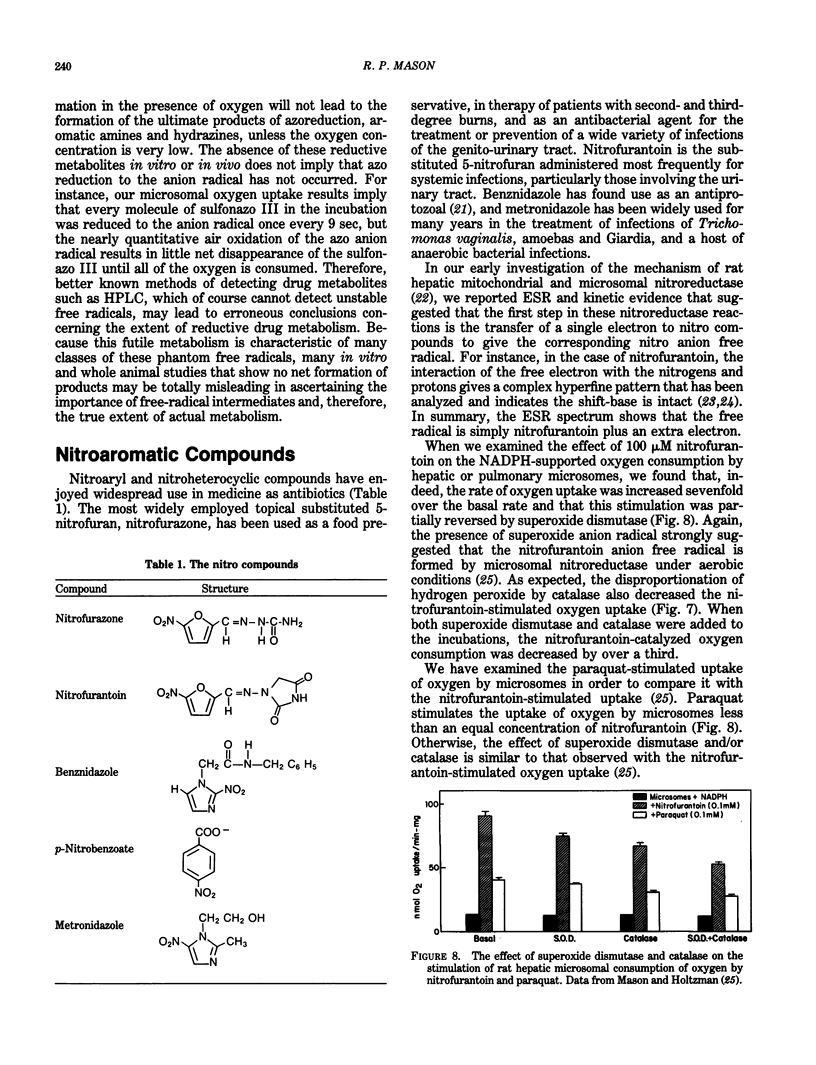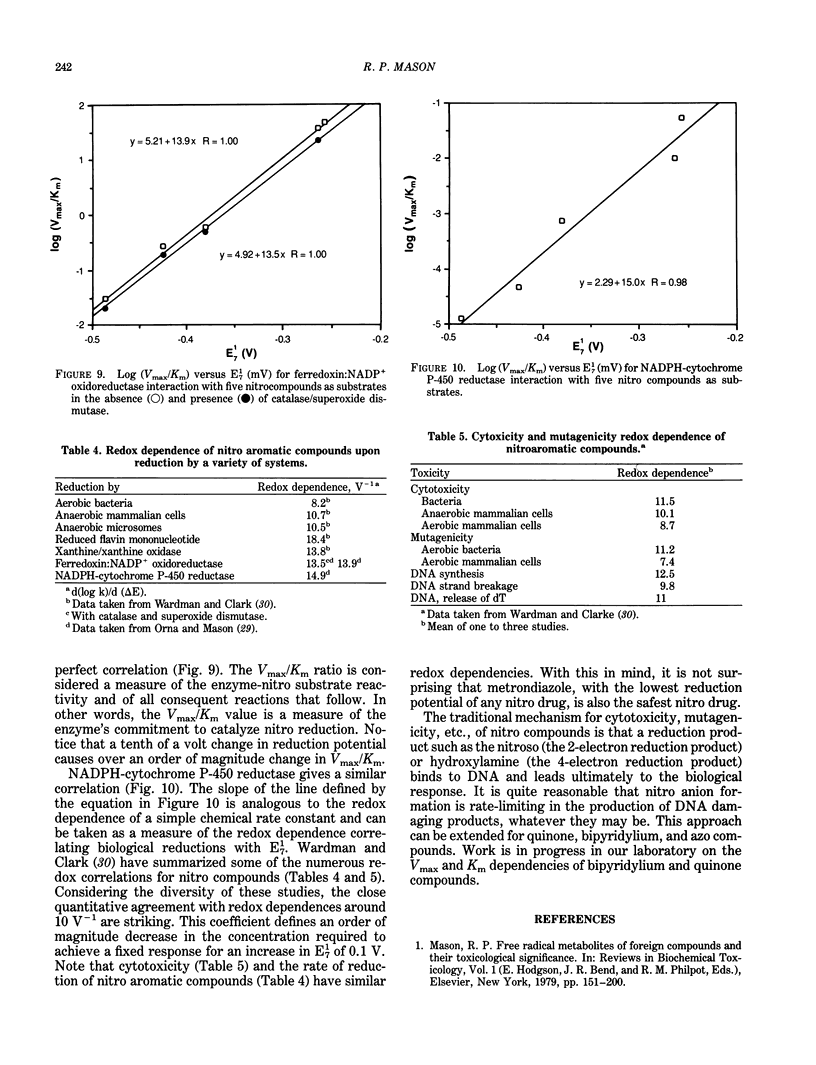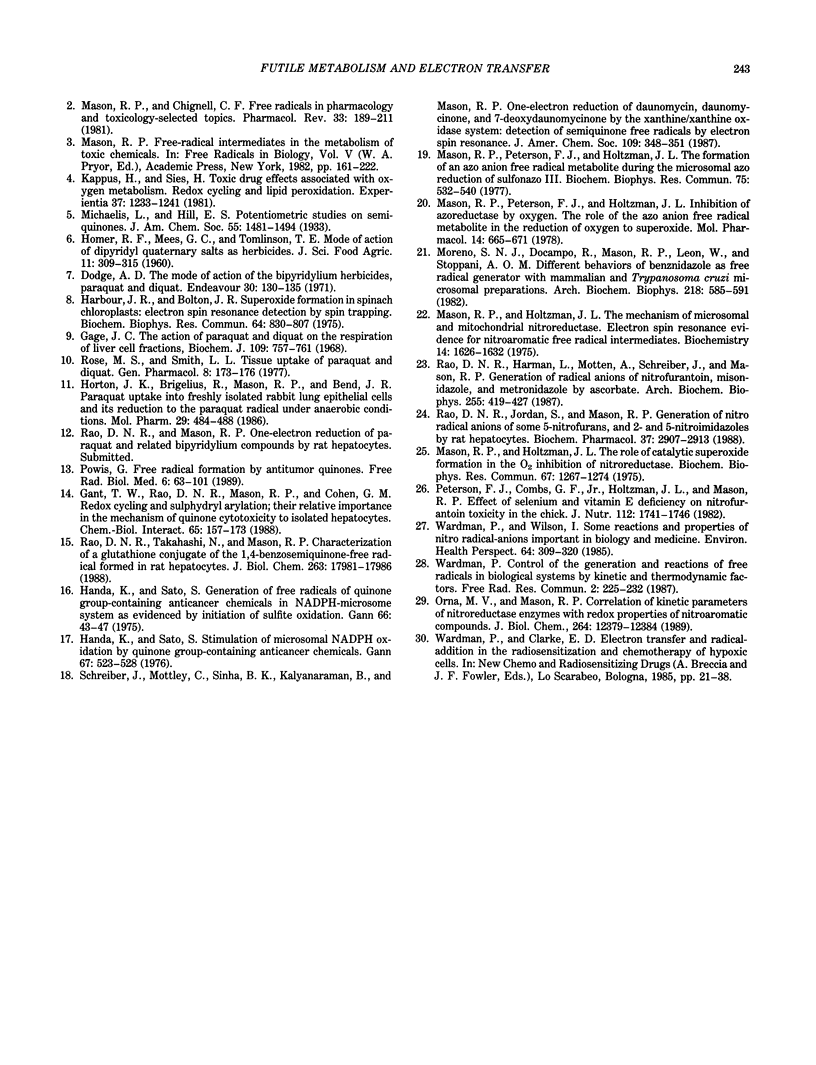Abstract
A wide variety of aromatic compounds are enzymatically reduced to form anion free radicals that generally contain one more electron than their parent compounds. In general, the electron donor is any of a wide variety of flavoenzymes. Once formed, these anion free radicals reduce molecular oxygen to superoxide and regenerate the parent compound unchanged. The net reaction is the oxidation of the flavoenzyme's coenzymes and the reduction of molecular oxygen. This catalytic behavior has been described as futile metabolism or redox cycling. Electron transfer theory is being applied to these reactions and, in some cases, has successfully correlated Vmax and Km with the reduction potentials of the aromatic compounds.
Full text
PDF






Selected References
These references are in PubMed. This may not be the complete list of references from this article.
- Dodge A. D. The mode of action of the bipyridylium herbicides, paraquat and diquat. Endeavour. 1971 Sep;30(111):130–135. doi: 10.1016/0160-9327(71)90039-1. [DOI] [PubMed] [Google Scholar]
- Gage J. C. The action of paraquat and diquat on the respiration of liver cell fractions. Biochem J. 1968 Oct;109(5):757–761. doi: 10.1042/bj1090757. [DOI] [PMC free article] [PubMed] [Google Scholar]
- Gant T. W., Rao D. N., Mason R. P., Cohen G. M. Redox cycling and sulphydryl arylation; their relative importance in the mechanism of quinone cytotoxicity to isolated hepatocytes. Chem Biol Interact. 1988;65(2):157–173. doi: 10.1016/0009-2797(88)90052-x. [DOI] [PubMed] [Google Scholar]
- Handa K., Sato S. Generation of free radicals of quinone group-containing anti-cancer chemicals in NADPH-microsome system as evidenced by initiation of sulfite oxidation. Gan. 1975 Feb;66(1):43–47. [PubMed] [Google Scholar]
- Handa K., Sato S. Stimulation of microsomal NADPH oxidation by quinone group-containing anticancer chemicals. Gan. 1976 Aug;67(4):523–528. [PubMed] [Google Scholar]
- Harbour J. R., Bolton J. R. Superoxide formation in spinach chloroplasts: electron spin resonance detection by spin trapping. Biochem Biophys Res Commun. 1975 Jan 2;64(3):803–807. doi: 10.1016/0006-291x(75)90118-7. [DOI] [PubMed] [Google Scholar]
- Horton J. K., Brigelius R., Mason R. P., Bend J. R. Paraquat uptake into freshly isolated rabbit lung epithelial cells and its reduction to the paraquat radical under anaerobic conditions. Mol Pharmacol. 1986 May;29(5):484–488. [PubMed] [Google Scholar]
- Kappus H., Sies H. Toxic drug effects associated with oxygen metabolism: redox cycling and lipid peroxidation. Experientia. 1981 Dec 15;37(12):1233–1241. doi: 10.1007/BF01948335. [DOI] [PubMed] [Google Scholar]
- Mason R. P., Chignell C. F. Free radicals in pharmacology and toxicology--selected topics. Pharmacol Rev. 1981 Dec;33(4):189–211. [PubMed] [Google Scholar]
- Mason R. P., Holtzman J. L. The mechanism of microsomal and mitochondrial nitroreductase. Electron spin resonance evidence for nitroaromatic free radical intermediates. Biochemistry. 1975 Apr 22;14(8):1626–1632. doi: 10.1021/bi00679a013. [DOI] [PubMed] [Google Scholar]
- Mason R. P., Holtzman J. L. The role of catalytic superoxide formation in the O2 inhibition of nitroreductase. Biochem Biophys Res Commun. 1975 Dec 15;67(4):1267–1274. doi: 10.1016/0006-291x(75)90163-1. [DOI] [PubMed] [Google Scholar]
- Mason R. P., Peterson F. J., Holtzman J. L. Inhibition of azoreductase by oxygen. The role of the azo anion free radical metabolite in the reduction of oxygen to superoxide. Mol Pharmacol. 1978 Jul;14(4):665–671. [PubMed] [Google Scholar]
- Mason R. P., Peterson F. J., Holtzman J. L. The formation of an azo anion free radical metabolite during the microsomal azo reduction of sulfonazo III. Biochem Biophys Res Commun. 1977 Apr 11;75(3):532–540. doi: 10.1016/0006-291x(77)91505-4. [DOI] [PubMed] [Google Scholar]
- Moreno S. N., Docampo R., Mason R. P., Leon W., Stoppani A. O. Different behaviors of benznidazole as free radical generator with mammalian and Trypanosoma cruzi microsomal preparations. Arch Biochem Biophys. 1982 Oct 15;218(2):585–591. doi: 10.1016/0003-9861(82)90383-6. [DOI] [PubMed] [Google Scholar]
- Orna M. V., Mason R. P. Correlation of kinetic parameters of nitroreductase enzymes with redox properties of nitroaromatic compounds. J Biol Chem. 1989 Jul 25;264(21):12379–12384. [PubMed] [Google Scholar]
- Peterson F. J., Combs G. F., Jr, Holtzman J. L., Mason R. P. Effect of selenium and vitamin E deficiency on nitrofurantoin toxicity in the chick. J Nutr. 1982 Sep;112(9):1741–1746. doi: 10.1093/jn/112.9.1741. [DOI] [PubMed] [Google Scholar]
- Powis G. Free radical formation by antitumor quinones. Free Radic Biol Med. 1989;6(1):63–101. doi: 10.1016/0891-5849(89)90162-7. [DOI] [PubMed] [Google Scholar]
- Rao D. N., Harman L., Motten A., Schreiber J., Mason R. P. Generation of radical anions of nitrofurantoin, misonidazole, and metronidazole by ascorbate. Arch Biochem Biophys. 1987 Jun;255(2):419–427. doi: 10.1016/0003-9861(87)90410-3. [DOI] [PubMed] [Google Scholar]
- Rao D. N., Jordan S., Mason R. P. Generation of nitro radical anions of some 5-nitrofurans, and 2- and 5-nitroimidazoles by rat hepatocytes. Biochem Pharmacol. 1988 Aug 1;37(15):2907–2913. doi: 10.1016/0006-2952(88)90275-4. [DOI] [PubMed] [Google Scholar]
- Rao D. N., Takahashi N., Mason R. P. Characterization of a glutathione conjugate of the 1,4-benzosemiquinone-free radical formed in rat hepatocytes. J Biol Chem. 1988 Dec 5;263(34):17981–17986. [PubMed] [Google Scholar]
- Rose M. S., Smith L. L. Tissue uptake of paraquat and diquat. Gen Pharmacol. 1977;8(3):173–176. doi: 10.1016/0306-3623(77)90045-3. [DOI] [PubMed] [Google Scholar]
- Wardman P. Some reactions and properties of nitro radical-anions important in biology and medicine. Environ Health Perspect. 1985 Dec;64:309–320. doi: 10.1289/ehp.8564309. [DOI] [PMC free article] [PubMed] [Google Scholar]
- Wardman P., Wilson I. Control of the generation and reactions of free radicals in biological systems by kinetic and thermodynamic factors. Free Radic Res Commun. 1987;2(4-6):225–232. doi: 10.3109/10715768709065287. [DOI] [PubMed] [Google Scholar]


